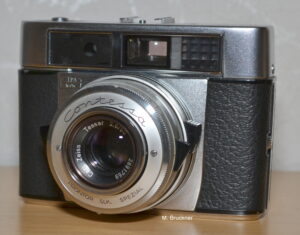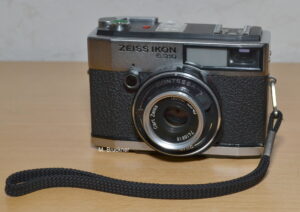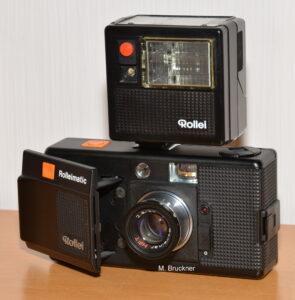Viewfinder Cameras
In the mid-1950s, when the German economic miracle was really gaining momentum, many people could afford the previously expensive hobby of photography. The increasing spread of the 135 35mm format also led to a move away from folding cameras, which were difficult to build, towards the rigid viewfinder camera we still know today. Equipped with a central locking lens with a focal length of 45-50mm and luxury models with an exposure meter and rangefinder, the quality of the built-in lens was crucial to whether the camera could produce decent images. Here is a small selection of different devices from the years 1954 to 1980

By far the most expensive 35mm viewfinder cameras in 1954 were the Contax models from Zeiss Ikon. Already successful on the market before the Second World War, the newly designed specimens were presented in time for the currency reform. As a system camera with interchangeable lenses; Accessories that made almost all photographic tasks solvable and equipped with incomparable stability, the camera series went onto the market at a price that corresponded to a quarter of a VW Beetle. Here is the reference book: „On the trail of the Contax“ by H.-J. Kuc, which describes in detail the development of this camera system.
Even after 65 years, the Contax IIIa shown here is a popular camera that delivers good results thanks to the precise distance meter and the sufficiently accurate light meter.

The Contina 1a was marketed as an entry-level model from 1955. It successfully replaced the expensive folding cameras of the first post-war years. Initially, the Contina had a striped chrome front and the flash connector at an angle on the lens. From 1956 that was changed. In 1957 the viewfinder, which was much too small, was enlarged. A Contina with „Pantar“ interchangeable lenses was also launched this year. The Novar lens installed on my camera with a speed of 1:3.5 is a three-lens construction that brings quite good results with sufficient light. Another advantage of this camera is the very quiet shutter, which allows discreet photography.

My beautiful Contina IIa with a built-in dual-zone light meter was an advanced model at Zeiss Ikon in 1956.
A lens that was sharp for the time and had a speed of 1:2.8 and enough leeway in the exposure times (1s-1/300s) should be enough to take good pictures. The classic angular Zeiss Ikon design with the beautifully knurled control knobs is still an icon of German camera construction. The light value is read off color-coded scales and set on the lens. Then the image section can be selected via the much too small viewfinder. When setting the distance, you had to rely on your sense of proportion, as unfortunately no rangefinder was installed.

The Zeiss Ikon company made a style change with their viewfinder cameras in the early 1960s. Shown here using a Contessa Matic E. The classic brick gave way to a rounded, almost softened shape.
The name Contessa was also resurrected after 5 years, but the whimsical charm of the folding camera was no longer achieved. Nevertheless, this camera is excellently equipped. A coupled range finder, a tracking exposure display that is visible in the viewfinder and the Zeiss-Tessar lens make photography a pleasure even today. The Prontor SLK shutter allows exposure times up to 1/500 second. There were a number of Contessas of this type, from the simplest without a rangefinder and slimmed-down shutters to the fully automatic Tenax. In the mid-1960s, the competition for entry-level cameras was increasing, making it increasingly difficult for Zeiss Ikon to sell their relatively high-priced cameras.

A joint development with the Voigtländer company, which had belonged to the group of companies since 1956, was intended to improve sales in the early 1970s. The Zeiss Ikon Contessa S 310 offered, for the first time in a Zeiss Ikon viewfinder camera, an electric CdS exposure meter and an electronic shutter speed control with automatic times of 4 seconds. up to 1/500sec in a compact housing that takes up the form of the 50s again. Only the pre-drive for the self-timer still works mechanically. The power supply is ensured by 4 button cells PX625 as standard. With a small intervention in the battery holder, however, a much cheaper 3 volt battery can be used. However, this small but quite heavy model could not stop the decline. The last Zeiss Ikon camera was made in 1972.
Let’s jump back to the year 1948. The 2nd World War has been lost for 3 years, the division of Germany is looming. The Soviet occupiers were diligently dismantling the Zeiss Ikon factory in Dresden, and the Zeiss Ikon company was re-entered in the Stuttgart commercial register and claimed all rights to the name.

Meanwhile, the pre-war Tenax is being rebuilt in modest numbers in Dresden. In 1953, the camera had to be renamed Taxona due to the naming rights and was given a permanently mounted viewfinder, a Tessar lens and a national shutter: the Tempor with a shortest exposure time of 1/300sec.
The Taxona is a neat little machine that weighs a lot despite its small size. The negative format is square with 24x24mm, so that there is no need to switch from portrait to landscape format. In conjunction with the short focal length of 37.5mm, the Tessar brings maximum sharpness. A take-anywhere camera. Unfortunately, an attached accessory shoe is missing. so that one has to make do with a flashing bracket. A popular extra was the cable release connection, which makes long-term exposures easily possible.

Another highlight from the former GDR production was the Werra series. For 12 years, the optics manufacturer Carl Zeiss manufactured cameras in Jena, this happened in Eisfeld on a dismantled production line from the Bruhns company in Hamburg. This camera series came onto the market in 1954 and in some cases differed greatly from the competition. Carl Zeiss later received an award for the simple design. Nothing disturbs the functional housing, all functions are housed directly on the lens, including cocking the shutter and film transport. The Werra cameras wind the shutter and transport the film with the rotating ring around the lens. Once you get used to using the camera, you can operate it incredibly quickly with one hand. The rewind wheel and the film indicator disc are mounted on the underside of the camera. The green housing color was standard and not a military version, black cameras are rarely found. The Werra’s exposure meter has a pinhole flap that should be opened in poor light conditions. A disc ruler for the read light value is located on the back wall. Later, interchangeable lenses and an automatic exposure system were even implemented.

A really nice piece of West German camera history is the Retinette II B by Kodak, which was produced until around 1958.
Although the company is of American origin, the best cameras were made in the former Nagel factory in Stuttgart. This Retinette II B can be equipped with a Synchro-Compur shutter with times of 1sec. up to 1/500sec. allowed and shine with a 4-lens Schneider-Kreuznach Reomar lens. The selenium exposure meter works like on the first day, the pictures I took with this camera are consistently successful. Unfortunately, Kodak only produced the simplest cameras (Instamatic) from the early 1960s, and the long tradition of quality was no longer salable. It should also be noted that the Retinette II B has by far the quietest shutter of all my cameras.

Here’s the little sister: the Kodak Retinette 1B.
Unlike the Retinette IIB, it has an exposure meter that is visible in the viewfinder, but has a cheaper camera shutter without long-term exposure and a film transport mechanism that is mainly made of plastic, which is also the reason for many defective Retinettes.
The latching pre-selection of the most common distances is helpful for setting the distance. (Portrait, group and infinity) What is striking about the camera is the strong pink coloring of the bright viewfinder.

The young Federal Republic of Germany learned to take photographs with this camera: in 1954 the long-awaited Agfa Silette was introduced.
Their daily production was at times 2,400 copies, which corresponds to around 3/4 million cameras a year!
This camera already had a quick switch lever, so the shutter lift was linked to the film transport. In the course of its production time it experienced numerous undocumented improvements in detail. In addition, they were also available with different lenses and shutters, as was common with practically all manufacturers at the time. My Agfa from the first series, which is still very nice, proves that even so-called cheap cameras can be solidly processed. The image quality doesn’t quite match that of the Zeiss Ikon or Kodak, but it is a light, handy camera that still does its job without complaint after more than 59 years.

The Rollei 35, designed by Heinz Waaske, was presented in 1966 by the Braunschweig camera manufacturer as the smallest 35mm camera in the world at the time.
Barely larger than a pack of cigarettes (height 9.7 cm * width 6 cm * depth 3.2 cm, approx. 375 g), it was a revolution in its day. To date, it is the smallest fully mechanical camera for commercially available 35mm film cartridges.
In about 30 years of production – all models together – about 2 million copies were made. Whole books have been written about the Rollei 35 and its development, so that a further description is unnecessary at this point. Only so much: It is a wonderful camera with its own logic that guarantees sharp images with its six-lens Sonnar lens.

Another interesting construction by H. Waaske is the Rolleimatic from 1980. At that time, the Rollei company was on the verge of financial collapse and a bestseller had to go into production as quickly as possible. In principle, the Rolleimatic corresponded to the ambitious goals, but series production was started without sufficient testing. The result: hardly any camera worked as it should, especially the electronics had to be constantly improved. After only one year of production at the Rollei plant in Singapore and approx. 30,000 units, it was over. The central design element is the multifunctional swingarm. When closed, it protects the viewfinder and lens. The lens (Rolleinar f/2.8 38mm) is also pushed in and out with the rocker and the film is transported. The shutter works in a time/aperture program from 1/500sec f/16 to 4sec f/2.8. LEDs visible in the viewfinder warn of long-term exposures from 1/30sec, which may require a tripod.

The Voigtländer Vito B was successfully sold from 1954 (with a small viewfinder) until around 1960.
The solid and handy camera found many friends thanks to its pleasing shape and the recognized good Color Skopar 1:3.5/50mm lens in the Prontor shutter with light value adjustment.
Typical of the Vito B was the “upside down” image count display, which the photographer could easily read by tilting the camera slightly.
A connection synchronized for all types of flash and a forward drive complete the overall good impression of this model.
Go to SLR Cameras or Home
